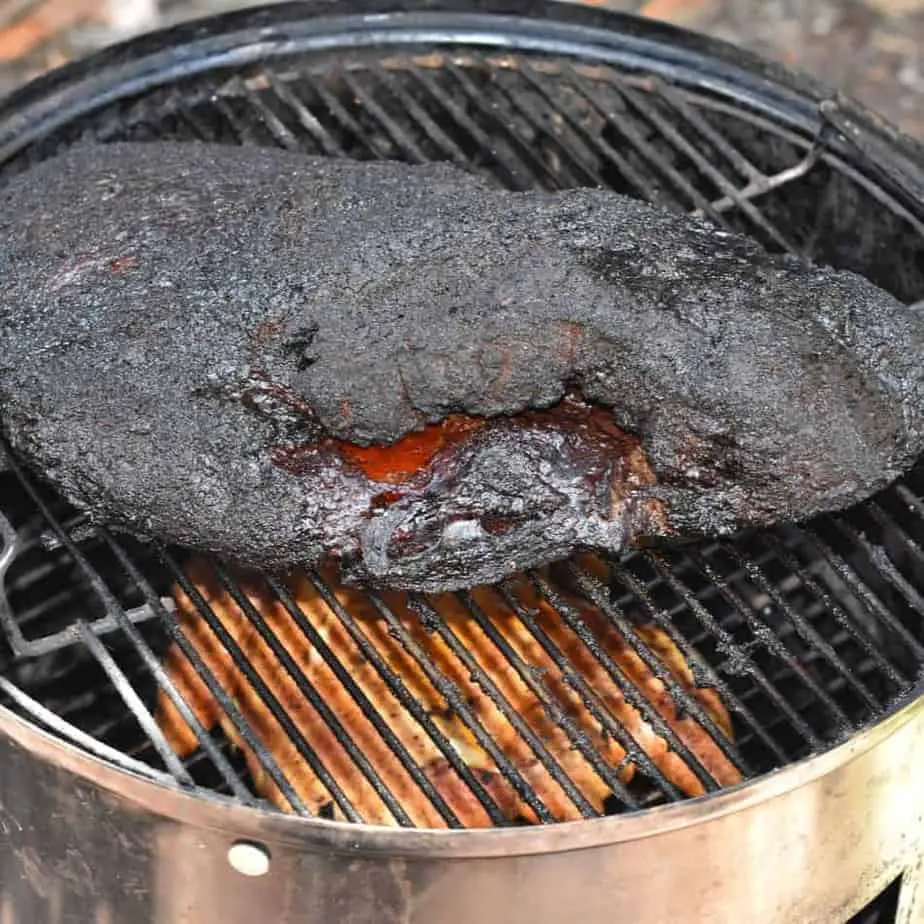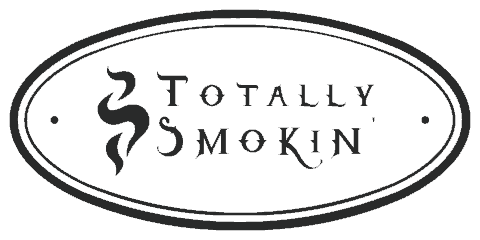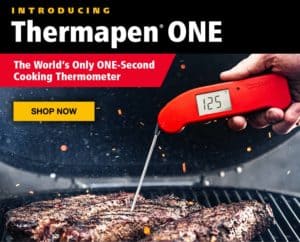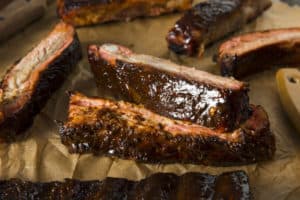Smoke Meat Without Drying it Out: 9 Tips for Juicy BBQ
Disclosure: This post may contain affiliate links. If you use these links to buy something we may earn a commission at not additional cost to you. Learn more.
Smoked meats are undeniably some of the best food you will ever taste, but ordering from an expensive BBQ restaurant and enjoying them is one thing while smoking your own is another. If you’re tempted to try smoking meat yourself, you’ll want to make sure it comes out as juicy as professional barbecue.
Here are 9 tips for how to smoke meat without drying it out:
- Always Use a Dry Rub with Salt
- Use Room Temperature Meats
- Know Your Meat
- Consider Your Cooking Times
- Control the Temperature
- Don’t Use Too Much Smoke
- Keep the Lid Closed
- Spray Meat Throughout the Cook
- Always Rest the Meat
Smoking meat is a delicate process, but as long as you follow these ten simple tips, you should have no trouble maintaining the overall juiciness of your meat. Remember that smoking takes plenty of time and energy, and you need to be patient to increase your chances of a successful smoking session.

1. Always Use a Dry Rub with Salt
A lot of barbecuers will apply a dry rub to their meat before cooking. This is because it adds an additional flavor to the meat, and it combines well with the delicious taste of smoke; producing incredible results.
While you can use any dry rub you choose, there is one thing that should always be found in your dry rub: salt.
Not only will salt add some additional flavor, but it is the ingredient responsible for ‘denaturing.’ This specific process is what allows the meat to hold in moisture while it’s smoking, which means you won’t have to worry as much about your meat drying out (unless it’s a lean cut of meat).
2. Use Room Temperature Meats
This is a little bit controversial: some chefs believe it’s best to deal with cold meat right out of the fridge while others think it should be room temperature. It will all depend on your specific likes and wants, but my experience has been that room temp is best.
This isn’t because room temperature meat has more flavor or can hold in moisture better; the simple reason why the meat should be room temperature before going into the smoker is that the temp of the meat is closer to the final result we’re looking for.
Think of it this way: room temperature meat won’t need to go from cold to room temperature and then to cooking temperature. Instead, it will start out a semi-warm temperature and be heated up somewhat easier. With less cooking time, you won’t have to deal with a higher chance of drying out.
3. Know Your Meat
In order to have a successful barbecue, you need to know your meat. Different meats will require different amounts of cooking time, marinades or dry rubs, flavor pairings for wood, and preparation.
For instance:
- A set of baby back ribs has a lot of membrane and fat and will need to be trimmed before cooking. Don’t take off so much fat that it will be prone to drying out, however. Also, baby back ribs will go well with a dry rub and mesquite or hickory wood.
- On the other hand, a chicken breast will need to be brined or marinated prior to smoking to help hold in moisture. Chicken breasts are lean and will dry out with not cared for properly. They’ll need to be sprayed throughout the smoking time and pairs well with oaky flavored woods.
- A large-sized brisket is going to be a tough challenge. This tough meat will need a dry rub, but all the fat allows it to stay moisturized while smoking. However, it will require a relatively large amount of time, anywhere from 6 to 14 hours, depending on the size.
Knowing your meat and how it should be prepared is crucial to successful BBQ. You want to make sure your meat has all that it needs to be flavorful and juicy, and that includes knowing the right wood flavor to pair it with.
While the flavor of the wood won’t have a direct impact in terms of juiciness, it’s still an essential factor to consider when barbecuing. Try and keep your dry rub and your wood flavor similar to amplify the overall taste. Sweet rubs should go with cherry or apple, while spicier and richer rubs should pair with mesquite nicely.

4. Consider Your Cooking Times
As much as you need to know your meat cut, it’s just as important to have an idea about the cooking time associated with it. A lot of recipes will state how much time is needed for your meat to be successfully smoked, but a good rule of thumb includes this:
- The bigger and thicker the cut, the more time will be needed to smoke it. Large cuts of meat like brisket could take anywhere from 6 to 14 hours, depending on the size.
- A lean cut of meat, such as pork chops or chicken breasts under one inch thick, can be smoked in as little as 1 ½ to 2 hours.
- Most regular-sized meats, such as a set of baby back ribs or a piece of steak, should be done in 4 to 6 hours.
- Turkey and poultry can be a little tricky to cook correctly. While beef can still be a bit pink inside and be safe to eat, turkey and poultry must be cooked thoroughly to avoid potential sickness.
Make sure you are aware of the cooking time for your particular cut of meat. You do not want to overcook the meat, or you will be destined to have a product that is charred and unpleasant tasting with an overload of smoky flavor.
Meat that isn’t cooked all the way is a potential hazard if you’re eating poultry, turkey, or pork, and should also be avoided. There is more leniency with beef, but you certainly do not want to serve meat that looks delicious on the outside, only to be left a bloody mess on the inside.
Do your research before tossing your meat into the smoker to avoid dryness, overcooking, and undercooking. These are surefire ways to make your smoking adventure a failure, so preparing ahead of time, and knowing the ins and outs of your cut are imperative.
Check out our guide to BBQ times and temperatures to get you started.
5. Control the Temperature
One of the biggest mistakes you can make while cooking is not controlling the temperature. If your temperature is fluctuating or is either too high or too low, you’re destined for failure.
Again, it comes down to proper planning and knowing your meat. While meat will need to be prepped in a certain way and require a certain length of cooking time, they also have specific requirements when it comes to the cooking temperature as well. However, most meats will smoke well on an average of 225 to 245 degrees Fahrenheit.
Tip: A great way to keep an eye on your temps without being tied to your smoker is by using one of the amazing remote thermometers from ThermoWorks.
If you’re not taking care of your temperature, you’re likely to mess up your meat in a big way:
- Too much heat and you will likely overcook and dry out your meat.
- Too little heat will lead to meat that isn’t cooked all the way through.
So how can you avoid this potential problem? Control the temperature using the air vents on the smoker. The air vent on the bottom (or wherever your heat source is) will allow you to raise and lower the temperature. If you need a higher temp, open it up. Need it cooler, close it down.

The air vent on the top of the smoker controls how much smoke is being released from the smoker. If you notice an excessive amount of smoke, you need to turn down the heat and let more smoke out of the smoker. Too much smoke can ruin your meat by drying it out and destroying the flavor.
To ensure you have the right temperature, you may want to purchase a thermometer that will allow you to check the temp of the inside of the smoker. Don’t solely rely on mounted thermometers as they typically won’t give you the correct temp. This is because the smoker will be hotter in some areas than others, and you will want to know the temperature of where the meat is.
6. Don’t Use too Much Smoke
When people think of a smoker, they may believe that there should be billows of smoke coming out of the smoker, and it will look like something out of the 1800s. The truth of the matter is, there should only be a small stream of smoke being released from the chimney.
What happens in you over smoke your meat? First and foremost, too much smoke will result in drying out your meat, which is exactly what you want to avoid. Excessive amounts of smoke will also have an impact on the flavor in the end, with most saying it is overwhelming and distasteful.
While you are ensuring the temperature of your smoker remains steady (typically around 225 and 245 degrees Fahrenheit), you should also ensure that the smoke remains steady as well. If you notice there is too much smoke coming out of the smoker, you need to turn down the heat.
If you notice that there is too little smoke coming out of the smokebox, this could be a result of the wood being burnt up. At this point, you will need to replace the wood to ensure the smoking is taking place, and the flavors are still being infused.

7. Keep the Lid Closed
This can’t be stressed enough: don’t open the lid. A smoker is nothing like a regular barbecue grill, where you can easily leave it open or check on it every 10 minutes, and nothing traumatic happens. It’s imperative while smoking to keep the lid shut.
Why is this such an important factor when smoking? It’s pretty simple: the more you open the lid, the more heat will be released from the smoker. This means that the overall cooking time will be extended, sometimes by up to 2 hours- which is a lot considering your meat is already needing several hours to cook.
There are certain times when the lid will need to be opened, however:
- About an hour after you begin smoking your meat, check on it. Make sure that there is some cooking taking place. At this point, you will be able to tell whether you need more or less heat, depending on how it looks.
- About an hour before the meat is supposed to be finished, check on it. The meat should be just about ready. It is essential to know when your meat is done cooking- some may take off the racks before they’re complete, leading to a meat failure.
- Some meat like pork chops and chicken breasts will need to be sprayed with water, apple juice, or butter to maintain flavor. This is because these cuts are lean with very little fat content, so they’re prone to drying out. You will need to spray these meats at least once every 2 hours.
- Most smokers will have the firebox on the outside of the actual area where the meat is placed, which means you can replenish the wood with ease. However, some cokers have the fire in the same chamber as the meat, and you will need to open the lid to replenish the wood for proper smoking.
While there are certain moments where the lid will need to be opened, it’s important to do this as little as possible. Opening the lid will severely impact the quality of the finished product, and will directly impact cooking time, temperatures, etc. So be patient, and let the smoker do its job.
8. Spray Meat Throughout the Cook
We’ve mentioned this a few times already, but we’re making a note of it again because it can really help in creating juicy BBQ.
While most beef products have enough fat to maintain their moisture during the smoking process, leaner meats (turkey, some porks, fish, and poultry) lack the same fat content; making them more prone to drying out (rather quickly, at that).
To make sure these lean cuts don’t dry out while smoking, you need to brine or marinate them before cooking. Brine is simply water and salt, while a marinade will have other exciting flavors. The brine or marinade should be used for at least an hour before smoking, but the best results come from letting the product sit for 24.
While your meat is being smoked, you will need to spray it with some moisture and fat to help it retain moisture.
Some great options to add during the smoking process:
- Just a splash of water will do the trick.
- Blend your water with some ingredients, like those found in your marinade or dry rub, to enhance the flavor and moisture at the same time.
- Apple juice is an excellent choice if you’ve chosen a sweeter dry rub and marinade for your meat, and is especially handy with apple-flavored wood.
- Butter: it’s loaded with fat and can really help to retain moisture. Toss some butter on top of your meat to make sure it doesn’t dry out while being smoked.
Just because you’re dealing with a leaner cut that lacks fat doesn’t mean you’re destined for failure or a dried out finished product. All it means is that you need to take more time, energy, and preparation to ensure it remains hydrated up until the end.

9. Always Rest the Meat
After waiting for several hours on your meat to smoke, it’s no wonder why people toss it on the picnic table ready to serve; but this may be a big mistake.
One important part of the entire smoking process is what happens directly after you take the meat off the racks. You can’t just slice it up and serve it the way it is… the meat needs to rest.
Resting your meat is imperative for several reasons:
- Allowing your meat to rest for at least 30 minutes will allow it to redistribute moisture back into the muscle fibers, resulting in juicer barbecue.
- During the resting period, the meat will also enhance its overall flavor and taste.
- Some may also want to toss on their favorite barbecue sauce or another type of sauce while the meat is resting.
Resting your meat is crucial. One of the best ways to do it is by wrapping it up in foil (with or without a sauce on top) and let it sit for at least 30 minutes before serving.
Tip: You may also consider resting your foiled meat it in an empty ice chest with some towels or blankets as insulation. This slows the cooling process down a bit and can really enhance the tenderness of the finished product.
Conclusion
Smoking meat can be a bit of a challenge that requires plenty of time and energy, but you can be successful and avoid dried out cuts by following these easy 9 tips for juicy BBQ.
Want to know about other mistakes to avoid? Check out my post on the most common BBQ mistakes and how to avoid them!







